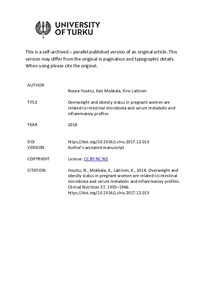Overweight and obesity status in pregnant women are related to intestinal microbiota and serum metabolic and inflammatory profiles
Houttu Nouttu; Mokkala Kati; Laitinen Kirsi
https://urn.fi/URN:NBN:fi-fe2022102462957
Tiivistelmä
Background: Overweight and obesity may predispose women to clinical complications during their pregnancy. We hypothesize that a higher degree of overweight status is related to a range of aberrations in biomarkers already in early pregnancy. Our objective was to investigate whether intestinal microbiota, serum metabolic and inflammatory profiles differ in relation to the degree of overweight status in pregnant women.
Methods: This study investigated 52 overweight and 47 obese pregnant women in early pregnancy. Fecal samples were analyzed for intestinal microbiota composition by 16S ribosomal RNA gene sequencing and Qiime pipeline. Circulating serum metabolites, including lipids, amino acids and GlycA, a marker of low-grade inflammation, were analyzed by NMR metabolomics and hsCRP was quantified by immunoassay. Serum zonulin levels were analyzed to depict intestinal permeability by Zonulin ELISA kit and LPS activity for endotoxemia by Limulus amebocyte lysate assay. The analyses were adjusted for multiple comparisons using Benjamini-Hochberg procedure for false discovery rate controlling.
Results: The relative abundance of bacterial family Prevotellaceae (adjusted P = 0.19) and markers of low-grade inflammation, hsCRP (P = 0.0015) and GlycA (P < 0.001) and three branched chain amino acids (isoleucine, adjusted P = 0.024; leucine, adjusted P = 0.026; valine, adjusted P = 0.10) and one aromatic amino acid (phenylalanine, adjusted P = 0.050) and concentrations of several VLDL particles and lipid measures in several VLDL particles were higher in obese pregnant women compared to their overweight pregnant counterparts (adjusted P < 0.12). In contrast, lipid measures in a few HDL particles and many fatty acids were lower in obese compared to overweight pregnant women (adjusted P < 0.12).
Conclusions: The detected alterations in intestinal microbiota and metabolic and inflammatory profiles related to obesity status may offer new alternative tools to supplement standard clinical measures to predict the risk for metabolic alterations during the early phase of pregnancy.
Kokoelmat
- Rinnakkaistallenteet [27094]
